Exploring Rome - June 08-09, 2002
June 8, 2002 - Introduction to Rome
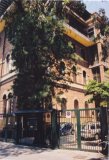 In the morning we met outside the residence and walked to the school; it was probably
one-and-a-half to two miles. Once there, we got an introduction to what we would be doing
and a schedule of events. Then, we split up into a couple of groups and took a brief
tour of the city, mainly the Old City. This included information on how to get around,
types of restaurants, how to order, how to use the buses and subway, where to purchase
tickets, how to read bus signs, and the different types of bus and subway tickets.
In the morning we met outside the residence and walked to the school; it was probably
one-and-a-half to two miles. Once there, we got an introduction to what we would be doing
and a schedule of events. Then, we split up into a couple of groups and took a brief
tour of the city, mainly the Old City. This included information on how to get around,
types of restaurants, how to order, how to use the buses and subway, where to purchase
tickets, how to read bus signs, and the different types of bus and subway tickets.
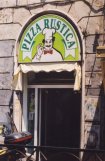 Our first stop was at Pizza Rustica (see right), which was located a half-dozen blocks
from the school, near the entrance of Flaminio station and across from Piazza del Popolo.
There are actually a lot of places called Pizza Rustica, but this was a really good one.
Pizza Rusticas normally sell by the slice, although the pizza is in large rectanglar
dishes and you order by weight. An eto is about the size of a normal piece of pizza in
the U.S. So you can ask for "un eto" and name a type of pizza or point to something that
looks good. I generally ordered "due eti margherita," for a couple of slices of plain pizza.
Note that "pepperoni" are little peppers, not spicy sausage. Eti is the plural of eto.
The pizza would be folded over and wrapped in wax paper. Getting lots of napkins is a
good idea.
Our first stop was at Pizza Rustica (see right), which was located a half-dozen blocks
from the school, near the entrance of Flaminio station and across from Piazza del Popolo.
There are actually a lot of places called Pizza Rustica, but this was a really good one.
Pizza Rusticas normally sell by the slice, although the pizza is in large rectanglar
dishes and you order by weight. An eto is about the size of a normal piece of pizza in
the U.S. So you can ask for "un eto" and name a type of pizza or point to something that
looks good. I generally ordered "due eti margherita," for a couple of slices of plain pizza.
Note that "pepperoni" are little peppers, not spicy sausage. Eti is the plural of eto.
The pizza would be folded over and wrapped in wax paper. Getting lots of napkins is a
good idea.
 Next, we walked down a fashionable road in the Old City from the Piazza del Popolo to the
Spanish Steps. The Spanish Steps are also the home to the Sunken Boat fountain. From
there we walked over to an excellent gelato shop (see picture at left), where they make
their own gelati. You can get a cup or a cone, un piccolo [small], un medio [medium], or
un grande [large]. A medium was usually more than I really needed to eat, which did not
stop me from ordering them frequently. They had a ton of flavors, and we were encouraged
to get some of the more exotic types: kiwi, cantaloupe, etc. However, while such flavors
were good, interesting, and different, after a few bites I usually had had enough. My
mainstay was chocolat y creme caramela. Yuuummmm!
Next, we walked down a fashionable road in the Old City from the Piazza del Popolo to the
Spanish Steps. The Spanish Steps are also the home to the Sunken Boat fountain. From
there we walked over to an excellent gelato shop (see picture at left), where they make
their own gelati. You can get a cup or a cone, un piccolo [small], un medio [medium], or
un grande [large]. A medium was usually more than I really needed to eat, which did not
stop me from ordering them frequently. They had a ton of flavors, and we were encouraged
to get some of the more exotic types: kiwi, cantaloupe, etc. However, while such flavors
were good, interesting, and different, after a few bites I usually had had enough. My
mainstay was chocolat y creme caramela. Yuuummmm!
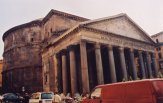 Our next stop, after the bathroom in Giolitti, was the Pantheon, just a few short, and
winding, blocks away. The Pantheon is not much to look at from the outside, just a big
block of concrete and stone. This brings up an interesting point about Roman buildings,
versus those of the Greeks. Roman buildings are normally designed to be viewed from the
inside, while Greek architecture usually stresses the outside.
Our next stop, after the bathroom in Giolitti, was the Pantheon, just a few short, and
winding, blocks away. The Pantheon is not much to look at from the outside, just a big
block of concrete and stone. This brings up an interesting point about Roman buildings,
versus those of the Greeks. Roman buildings are normally designed to be viewed from the
inside, while Greek architecture usually stresses the outside.
 Speaking of the inside, the dome was really quite impressive. It was cast as a single,
large piece of concrete. It is unclear how they got this massive dome up there, or even
exactly how it was manufactured. It gets thinner as it gets to the top, and has a hole
in the center to let in light. The dome in St. Peter's is slightly smaller in deference to
this incredible structure. There are various tombs and chapels within the Pantheon, as it
is, after all, a House of Gods. It also has huge bronze doors, or possibly it did before
they were melted down to make weapons. Most bronze was melted down to make weapons at
some point.
Speaking of the inside, the dome was really quite impressive. It was cast as a single,
large piece of concrete. It is unclear how they got this massive dome up there, or even
exactly how it was manufactured. It gets thinner as it gets to the top, and has a hole
in the center to let in light. The dome in St. Peter's is slightly smaller in deference to
this incredible structure. There are various tombs and chapels within the Pantheon, as it
is, after all, a House of Gods. It also has huge bronze doors, or possibly it did before
they were melted down to make weapons. Most bronze was melted down to make weapons at
some point.
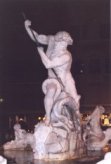 From the Pantheon we headed a few more blocks to the Piazza Navona. This was a bit
difficult to find because it is built over the former location of a circus and all of the
buildings face in to form almost a complete ring. This means that there are only a few
entrances in the form of alleys between the buildings. Inside are several restaurants
and cafes, many vendors, and a couple of cool fountains.
From the Pantheon we headed a few more blocks to the Piazza Navona. This was a bit
difficult to find because it is built over the former location of a circus and all of the
buildings face in to form almost a complete ring. This means that there are only a few
entrances in the form of alleys between the buildings. Inside are several restaurants
and cafes, many vendors, and a couple of cool fountains.
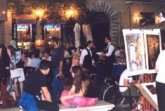 On one side of the Piazza was a church which was very clean on the bottom, but the top
looked the worse for wear. Apparently when the cleaning budget runs out they simply stop
work, pack up their gear, and go home. Perhaps, in another ten years, more money will be
allocated and they will finish the job. Or, perhaps not. The first of the fountains is
the Triton Fountain (at right), which includes a triton jabbing an octopus with a spear.
It is interesting because it is mostly stone but the spear is metal. In addition to the
Triton Fountain, there is also the Fountain of the Four Rivers (below). This fountain has
representations of the largest rivers of the four known continents, or quarters of the
world. The Danube, for Europe, the Plata, for the Americas, the Ganges, for Asia, and the
Nile, for Africa. The fountain was designed and built by Bernini around 1650. Of especial
note is the representation of the Nile, which is veiled, as the headwaters of the Nile had
not yet been found.
On one side of the Piazza was a church which was very clean on the bottom, but the top
looked the worse for wear. Apparently when the cleaning budget runs out they simply stop
work, pack up their gear, and go home. Perhaps, in another ten years, more money will be
allocated and they will finish the job. Or, perhaps not. The first of the fountains is
the Triton Fountain (at right), which includes a triton jabbing an octopus with a spear.
It is interesting because it is mostly stone but the spear is metal. In addition to the
Triton Fountain, there is also the Fountain of the Four Rivers (below). This fountain has
representations of the largest rivers of the four known continents, or quarters of the
world. The Danube, for Europe, the Plata, for the Americas, the Ganges, for Asia, and the
Nile, for Africa. The fountain was designed and built by Bernini around 1650. Of especial
note is the representation of the Nile, which is veiled, as the headwaters of the Nile had
not yet been found.
Next, we headed across the river to a cafe and had some wine, while sitting around watching
the crowds go by. We walked over a bridge that is about 2,500 years old and spans the
river from one of the small islands originally inhabited by the early Romans. We went
through the Jewish Ghetto and headed over to Capoline Hill.
 Capoline Hill is one of the five main hills in Rome, in fact it is the largest. That is
why it has traditionally housed the capitol (hence Capoline). The Victor Emmanuel building,
which houses Italy's government, is located on the hill, along with a couple of museums.
In the center of the square on top of the hill is the last remaining bronze statue from the
Roman era (see left). It survived because it was thought by the Christians to be a statue
of the Christian Emperor Constantine, although it was another Emperor.
Capoline Hill is one of the five main hills in Rome, in fact it is the largest. That is
why it has traditionally housed the capitol (hence Capoline). The Victor Emmanuel building,
which houses Italy's government, is located on the hill, along with a couple of museums.
In the center of the square on top of the hill is the last remaining bronze statue from the
Roman era (see left). It survived because it was thought by the Christians to be a statue
of the Christian Emperor Constantine, although it was another Emperor.
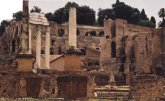 Between Capoline Hill and the Colosseum is the Roman Forum (see right). The Forum is a
collection of buildings, including temples and administrative buildings, that were contructed
throughout the Imperial period by numerous Emperors. Most of the buildings are reduced to
a few columns, a wall or two, or their lower portions. We walked through the Forum and
past the Colosseum and split up at the subway station at Colosseo. I got a monthly subway
pass for June and caught the subway back to the Residence.
Between Capoline Hill and the Colosseum is the Roman Forum (see right). The Forum is a
collection of buildings, including temples and administrative buildings, that were contructed
throughout the Imperial period by numerous Emperors. Most of the buildings are reduced to
a few columns, a wall or two, or their lower portions. We walked through the Forum and
past the Colosseum and split up at the subway station at Colosseo. I got a monthly subway
pass for June and caught the subway back to the Residence.
June 9, 2002 - Trip to Todi
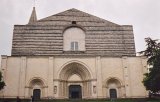 In the morning, we got up early and took a couple of chartered coaches to Todi, a medieval
hill town a couple of hours north of Rome. As we entered Todi, I was near our guide from
the prior day. He explained the significance of some of the buildings and architecture, as
well as explaining why the church at the top of the hill (see left) only had facing on the
bottom. Apparently, as with modern cleaning, when the money runs out they stop building
. . . and in some cases never restart.
In the morning, we got up early and took a couple of chartered coaches to Todi, a medieval
hill town a couple of hours north of Rome. As we entered Todi, I was near our guide from
the prior day. He explained the significance of some of the buildings and architecture, as
well as explaining why the church at the top of the hill (see left) only had facing on the
bottom. Apparently, as with modern cleaning, when the money runs out they stop building
. . . and in some cases never restart.
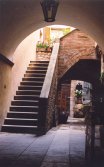 It had winding streets and cool little alleys, sometimes ending up with cool arches and
stairways (see right). We spent a couple of hours walking through the streets, checking
out shops, and taking pictures. We headed back to the coaches and drove to a place for
lunch. The place we went to served traditional Italian meals, as in about a dozen courses.
I tried pretty much everything, although only a little of most things. That is the real
key, not gorging yourself on things, because there are a lot more courses coming.
It had winding streets and cool little alleys, sometimes ending up with cool arches and
stairways (see right). We spent a couple of hours walking through the streets, checking
out shops, and taking pictures. We headed back to the coaches and drove to a place for
lunch. The place we went to served traditional Italian meals, as in about a dozen courses.
I tried pretty much everything, although only a little of most things. That is the real
key, not gorging yourself on things, because there are a lot more courses coming.
After lunch we walked around the grounds for a little while and then headed back to Rome.
I chatted with a few of the other students about the possibility of doing some weekend
trips. Several people seemed interested in hitting Naples and Venice, and one of the
people seemed willing to go to Paris after finals were over.
| Home | Rome Journal Home |
© 2004 John Eisinger. All rights reserved
Please report any problems to me.
 Our first stop was at Pizza Rustica (see right), which was located a half-dozen blocks
from the school, near the entrance of Flaminio station and across from Piazza del Popolo.
There are actually a lot of places called Pizza Rustica, but this was a really good one.
Pizza Rusticas normally sell by the slice, although the pizza is in large rectanglar
dishes and you order by weight. An eto is about the size of a normal piece of pizza in
the U.S. So you can ask for "un eto" and name a type of pizza or point to something that
looks good. I generally ordered "due eti margherita," for a couple of slices of plain pizza.
Note that "pepperoni" are little peppers, not spicy sausage. Eti is the plural of eto.
The pizza would be folded over and wrapped in wax paper. Getting lots of napkins is a
good idea.
Our first stop was at Pizza Rustica (see right), which was located a half-dozen blocks
from the school, near the entrance of Flaminio station and across from Piazza del Popolo.
There are actually a lot of places called Pizza Rustica, but this was a really good one.
Pizza Rusticas normally sell by the slice, although the pizza is in large rectanglar
dishes and you order by weight. An eto is about the size of a normal piece of pizza in
the U.S. So you can ask for "un eto" and name a type of pizza or point to something that
looks good. I generally ordered "due eti margherita," for a couple of slices of plain pizza.
Note that "pepperoni" are little peppers, not spicy sausage. Eti is the plural of eto.
The pizza would be folded over and wrapped in wax paper. Getting lots of napkins is a
good idea. In the morning we met outside the residence and walked to the school; it was probably
one-and-a-half to two miles. Once there, we got an introduction to what we would be doing
and a schedule of events. Then, we split up into a couple of groups and took a brief
tour of the city, mainly the Old City. This included information on how to get around,
types of restaurants, how to order, how to use the buses and subway, where to purchase
tickets, how to read bus signs, and the different types of bus and subway tickets.
In the morning we met outside the residence and walked to the school; it was probably
one-and-a-half to two miles. Once there, we got an introduction to what we would be doing
and a schedule of events. Then, we split up into a couple of groups and took a brief
tour of the city, mainly the Old City. This included information on how to get around,
types of restaurants, how to order, how to use the buses and subway, where to purchase
tickets, how to read bus signs, and the different types of bus and subway tickets.







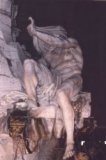



 In the morning, we got up early and took a couple of chartered coaches to Todi, a medieval
hill town a couple of hours north of Rome. As we entered Todi, I was near our guide from
the prior day. He explained the significance of some of the buildings and architecture, as
well as explaining why the church at the top of the hill (see left) only had facing on the
bottom. Apparently, as with modern cleaning, when the money runs out they stop building
. . . and in some cases never restart.
In the morning, we got up early and took a couple of chartered coaches to Todi, a medieval
hill town a couple of hours north of Rome. As we entered Todi, I was near our guide from
the prior day. He explained the significance of some of the buildings and architecture, as
well as explaining why the church at the top of the hill (see left) only had facing on the
bottom. Apparently, as with modern cleaning, when the money runs out they stop building
. . . and in some cases never restart.
